3-3 running crane. cork and ball types. application in
In this article we have to figure out what the 3-way valve is and for what purposes it can be used in modern plumbing systems. In addition, we will get acquainted with the typical problems of these cranes on heating in the houses of the old stock and find out what can be replaced with them when repairing the supply pipe to the radiator.
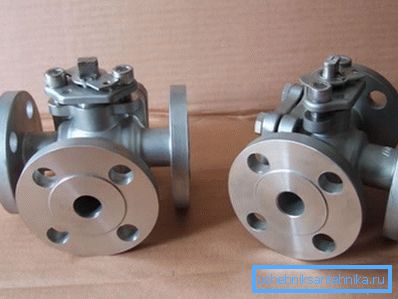
What it is
The 3-way valve is quite predictably different from an ordinary valve by the presence of not two, but three conclusions.
In this case, the conclusions can be very different:
- Threaded (clutch);
- Flanged;
- Collet (fast clamping);
- Finally, the conclusion can and does represent a drainage hole for the discharge of the working environment.
The functionality of the product is also quite obvious: it allows you to configure the engineering system with the maximum variety of directions of movement of the working environment. Depending on the position of the crane in its case, a jumper can be created between any two or three branches. Of course, this type of valves also allows to completely block them.
Kinds
Plumbing taps of this type, found on sale in our time, can be divided into two main categories depending on their device.
Cork
Adjustment of the crane is carried out by changing the position of the cork with the shaped cut in it.
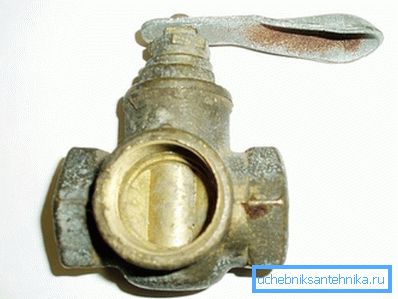
Products may vary:
- Cork and stem sealing method. There are three options:
| Sealing method | Description |
| Gland packing | The cork rotates in a hollow case from the bottom and is pressed on top with a nut-socket. A graphite gland under the nut ensures no leakage from under the stem. The main drawback of the gland is that it is produced even with a simple valve due to the leaching of graphite particles |
| Rubber compressor | Instead of an epiploon the rubber ring is used. Unlike the gland, it wears out only when the working position of the plug changes. |
| Lapping cork | The tightness of the long plug valves is provided by lapping the conical plug to the body. Cork is attracted to him by a nut on a passing through shank |
Useful: three-way valves for heating in houses built in the 60-70s of the last century are sealed solely with a gland. Its development is the cause of constant leaks on the stock at any turn of the cork.
- The presence or absence of the handle. In the latter case, the cork is rotated with an open-ended, pipe wrench or gas wrench.
- Body material and cork. For their manufacture are used metals with low friction - brass and cast iron.
Ball
Sharovy 3kh running crane is an evolutionary development of the previous design:
- The cork has acquired the shape of a regular ball with a shaped slot and a surface with the highest quality of processing, which guarantees minimum turning effort.
- Tightness is ensured by Teflon or PTFE seats - materials with a minimum coefficient of friction.
- The stem is sealed with an o-ring seal - rubber or polymer.
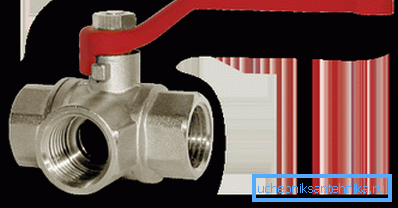
What is the result?
- The crane resource is not less than 500 operations (more often - 2000 and more).
- Repair and maintenance are reduced to a rare tightening of the nut, pressing the stem seal.
- The switching force of the crane is much less than that of cork cranes.
By the way: it is proportional to the nominal diameter of the crane. In the case of large sizes, gearboxes with manual transmission or servomotors can be used for switching.
The price of three-way cranes of both types varies slightly, which makes the more capricious and difficult to maintain cork products of low demand in heating and water supply systems.
Application
Where are three-way cranes used? Of course, we are primarily interested in their use in the installation of plumbing systems with their own hands.
Underfloor heating systems, heat accumulator circuits
In both cases, a partially independent heating circuit is formed with its own circulation pump. To adjust the temperature, it uses partial recirculation of the return coolant.
Three-pass is placed on the connection of the supply and jumpers with the return; It is this one that allows you to adjust the temperature of the mixture.

Useful: to automate temperature control, it is often supplied with a servo drive, which adjusts the temperature depending on the readings of the remote temperature sensor.
Installation of gauges
One of the problems of mechanical pressure gauges is sticking of an arrow during long-term operation under pressure. To relieve pressure without dismantling the device, a three-pass is used: when the handle is turned, it not only blocks the control outlet of the line, but also relieves pressure above the stop plug or ball through the drain hole.

Adjustment of heating devices
It is in this capacity that the three-pass cranes were used in the Khrushchev houses already mentioned by us. They were installed on the connection of the lower liner to the radiator and jumpers.
This crane has four working positions:
- All the water goes through the radiator with the jumper blocked.
- Water goes through the jumper and radiator.
- Water goes through the jumper when the radiator is closed.
- The jumper and radiator are completely blocked, circulation in the riser is blocked.
In addition to the perpetual leaks on the stock, the last position of the crane created a lot of problems for the owners and their neighbors: finding the culprit in the absence of heating from the entire riser sometimes became a non-trivial task.
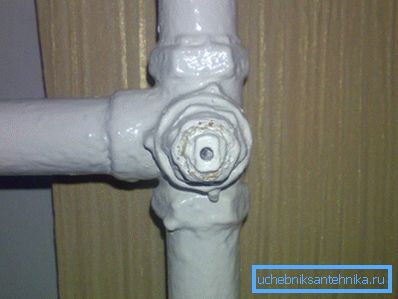
Since we have touched on this dubious design, the author will allow himself to recommend the configuration of valves on the heating device, creating a minimum of problems in the future:
- A ball valve is installed on the lower connection to the radiator after the lintel. Normal, two pass.
- On the upper liner - also after the lintel - mounted choke. It is at the top - because it collects less sludge and debris that can affect the throttling of the radiator.
- The jumper is made without shut-off valves, but with a nominal diameter one step less than the control lines of the supply pipes.
It is this assembly instruction that will provide maximum heat with flexible adjustment of heat transfer and the complete absence of problems for the owner and neighbors.
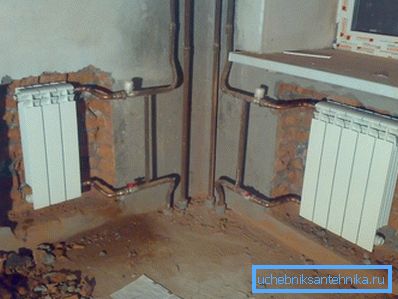
Conclusion
We hope that we were able to answer all the questions that have accumulated in the reader. Additional information about the device, types and features of the use of three-way cranes can be found in the video in this article. Successes!